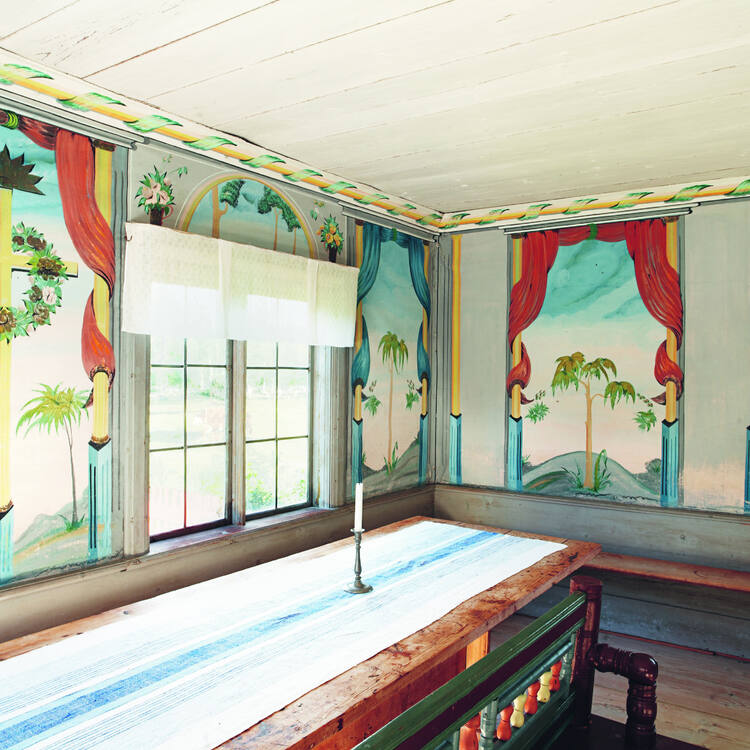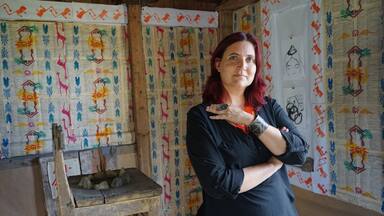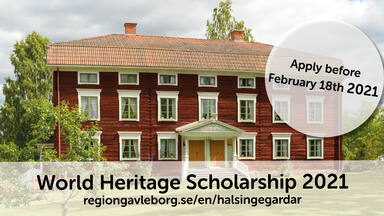Decorated Farmhouses of Hälsingland
Decorated Farmhouses of Hälsingland
Seven timber houses are listed in this site located in the east of Sweden, representing the zenith of a regional timber building tradition that dates back to the Middle Ages. They reflect the prosperity of independent farmers who in the 19th century used their wealth to build substantial new homes with elaborately decorated ancillary houses or suites of rooms reserved for festivities. The paintings represent a fusion of folk art with the styles favoured by the landed gentry of the time, including Baroque and Rococo. Decorated by painters, including known and unknown itinerant artists, the listed properties represent the final flowering of a long cultural tradition.
Description is available under license CC-BY-SA IGO 3.0
Fermes décorées de Hälsingland
Sept maisons de bois composent ce site de l’est de la Suède qui représente l’apogée de cette tradition régionale de construction en bois qui remonte au Moyen âge. Cette tradition reflète la prospérité des fermiers indépendants qui utilisèrent leurs richesses, au XIXe siècle, pour construire d’imposantes nouvelles demeures avec des bâtisses entières ou des enfilades de salles entièrement réservées aux fêtes. Les peintures témoignent de la fusion de l’art populaire et des styles prisés par l’aristocratie terrienne tels que le baroque ou le rococo. Décorés par des peintres, artistes itinérants connus ou inconnus, les biens représentent l’épanouissement final d’une tradition culturelle profondément enracinée.
Description is available under license CC-BY-SA IGO 3.0
Granjas decoradas de Hälsingland
El sitio consiste en siete casas de madera situadas al este de Suecia que representan el apogeo de la construcción en madera en la región, una tradición que se remonta a la Edad Media. Reflejan la posteridad de los granjeros independientes que, en el siglo XIX, utilizaron sus riquezas para construirse viviendas nuevas con salas o habitaciones auxiliares profusamente decoradas reservadas para las festividades. Las pinturas que las adornan representan la fusión del arte folk con los estilos preferidos por la aristocracia terrateniente de la época, entre ellos el barroco y el rococó. Decorados por pintores y artistas conocidos o desconocidos que viajaban de una a otra, los sitios inscritos representan el florecimiento final de una larga tradición cultural.
source: UNESCO/CPE
Description is available under license CC-BY-SA IGO 3.0
ヘルシングランドの装飾農場家屋群
source: NFUAJ
Versierde boerderijen van Hälsingland
Source: unesco.nl
Outstanding Universal Value
Brief synthesis
In a comparatively small area of north-eastern Sweden, bordering the Gulf of Bothnia and known as Hälsingland, are a concentration of large richly decorated, wooden farmhouses and associated farm buildings reflecting the peak of prosperity for the farming landscape in the 19th century and the social status of its farmers.
Seven large timber farmhouses with richly decorated interiors are part of a concentration of over a thousand surviving timber structures in the Hälsingland area, dating mainly from the 18th and 19th centuries that reflect a timber building tradition that originated in the Middle Ages (12th-16th centuries AD).
The farmhouses, set in long fertile valleys within the Taiga forest landscape, reflect the prosperity of independent farmers who used economic surplus from their exploitation of flax and woodland to build substantial new houses with entire buildings or suites of rooms used solely for festivities. The owners commissioned artists from Hälsingland or itinerant painters from neighbouring Dalarna to provide highly decorative interiors to reflect their social status. These decorated houses combine local building and local folk art traditions in a highly distinctive way that can be seen as the final flowering of a folk culture with deep roots in north-west Europe.
The seven houses are spread across an area 100 km from east to west and 50 km north to south. Six of these are in Hälsingland Province with a seventh just across the border in Dalarna Province – although this area was culturally part of Hälsingland in the 1800s.
A particularly distinctive feature of the farmhouses is the provision of either a separate house, a Herrstuga, or rooms in the main house, set aside for festivities, special occasions or assemblies, and hardly used for the rest of the year. These rooms were usually the most highly decorated in the farmstead. Decoration consists of canvas or textile paintings affixed to the walls, or paintings directly onto the wooden ceilings or walls, some supplied in the 19th century by itinerant painters from neighbouring Dalarna, and known as Dalecarlian paintings. The subjects were often biblical but with the people depicted in the latest fashions of the time. The painting style can be seen as a fusion of popular art and contemporary landed-gentry styles, such as Baroque, Rococo or “le style gustavien”.
The seven farmhouses are Kristofers farm, Stene, Järvsö, Gästgivars farm, Vallstabyn, Pallars farm, Långhed, Jon-Lars farm, Långhed, Bortom åa farm, Gammelgården, Bommars farm, Letsbo, Ljusdal, and Erik-Anders farm, Askesta village, Söderala. All have a number of decorated rooms for festivities (between four and ten), largely intact ranges of farm buildings, and are sited within a landscape context that has the capacity to reflect their agrarian function.
Criterion (v): The large, impressive farmhouses of Hälsingland, with their highly decorative rooms for festivities, reflect an extraordinary combination of timber building and folk art traditions, the wealth and social status of the independent farmers who built them, and the final flowering of a long cultural tradition in Hälsingland.
Integrity
Each of the seven farmhouses contributes strongly to the overall outstanding universal value of the property in terms of displaying highly decorated festivities rooms in timber buildings, within an overall farmstead and within an open landscape that reflects its agrarian origins. Also each farmstead reflects slightly different aspects of the way farmhouses incorporated rooms for festivities and the types of decorations that were applied by different artists. Together the seven sites display all the attributes of Outstanding Universal Value.
None of the attributes can be said to be vulnerable.
Authenticity
All the farmhouses have been selected to show the relationship between the festivities rooms and the rest of the farmstead, for their good state of preservation and for their ability to display the full range of responses in architectural and decorative terms.
Together the seven components can be said to include all the attributes necessary to convey fully and truthfully Outstanding Universal Value. The repairs and restoration of individual elements have been undertaken by skilled professionals using mostly traditional materials and techniques. The exception is the roofing of farmhouses and farm buildings where traditional roofing material has been replaced by more modern materials in order to ensure the protection of the decorative rooms. In a very few cases, wall decoration has been reconstructed but these do not relate to the key rooms decorated between 1800 and 1870. Five of the sites are still directly associated with farming activities. The exceptions are Gästgivars and Bortom åa but these retain their agricultural surroundings.
Protection and management requirements
All components of the property are protected as cultural heritage buildings under the Cultural Heritage Act, 1988 and this ensures protection of the fabric and decorated interiors.
All the buffer zones, except Bommars, have been designated as areas of national interest for the conservation of the cultural environment under the Environmental code, 1988. That for Bommars needs to be extended to encompass the visible village landscape and given national protection.
For all the buffer zones, special protection measures have been draw up, under the Planning and Building Act, 1987. These allow for building permits to be requested even where these are not mandatory. The protective measures afforded by the buffer zone are included in the Municipal Plans. All municipalities have given assurances that all measures at their disposal will be used to protect the areas from unsuitable development.
All but one of the components of the property are in private ownership. There is thus a high reliance on private owners having the resources and competences to carry out maintenance, on-going conservation of buildings, and to keep agricultural practices alive in the surrounding farmland. As there is a long standing tradition of local craftsmanship in Hälsingland, this traditional protection currently works well.
The overall management of the series is undertaken by a World Heritage Management Committee. It consists of the farmhouse owners and authorities with a supervisory responsibility (the County Administrative Board and the municipalities) as well as other actors which have a vested interest in the development and continued existence of the property, such as local and county museums, the local development agency and the University of Gävle. The partners in the management committee will make decisions on measures to protect the property’s values in accordance with Swedish legislation. The management committee also functions as a forum for raising important and current issues related to conservation and preservation, educational initiatives, sustainable development as well as participation and collaboration.
The Committee reports annually to the National Heritage Board.
A management plan for the property sets out over-arching objectives and areas for priority work. The Management Plan awaits approval by the County Governor. The Management Plan will be implemented by the World Heritage Management Committee and facilitated by a World Heritage Coordinator.
The value of the seven houses is conveyed by the smallest details of the decorated interiors. Although the state of conservation of the decorations is currently good, there is a need to benchmark what is there now and to document conservation history for each of the houses to underpin future monitoring.
The greatest threat to the seven components of the property is fire and there is an urgent need for fire protection policies to be in place for all components, within the context of overall emergency response policies. This process has now been started and will be enacted during 2012.







